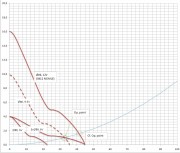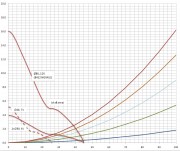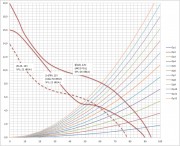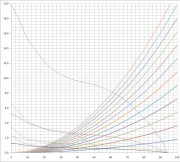(In that topic I wrongfully posted some fauly conclusions, which I hope to rectify herein.)
Summary:
2 fans in parallel are more quiet than one (especially for less restricted air paths)
Larger fans are more quiet than smaller (especially for less restricted air paths)
2 small fans in parallell are more quiet than one large fan (especially for less restricted air paths)
Background (Fan and air path theory, skip if you know this already)
Figure 1 show the basic relationship between flow and pressure in a system with a fan pushing air through an air path (eg a PC case). At the operating point there's equilibrium between what head the fan can give and the pressure loss in the air path. (Flow rate on horizontal axis, pressure on vertical axis.)

(Figure 1)
Figure 2 illustrates what happens to flow and pressure if you lower the voltage (and hence the RPM) to the fan. Both head and pressure loss is lowered in relation to the square of the flow rate.
Noise for the new op. point is lowered by [50 x log (RPM2/RPM1)], in this situation with only half of the RPM this calculates to 15 dB.

(Figure 2)
1 fan vs 2 fans
Figure 3 shows the comparison between using two fans in parallel vs only one fan. Here the two fans work at half RPM, ie 15 dB less than at nominal RPM - but since they are two, you have to add them, which dB calculates as [ Lp + Lp = Lp + 3 dB ], equalling a 12 dB noise drop total.
With a single fan operating in the same point, voltage has to be lowered to 9.3 V, giving a noise drop of 5 dB. So, we can conclude that for this particular case 2 fans give less noise than one.

(Figure 3)
Figure 3A shows what happens when impedance is variated - as impedance goes up, the single fan is going slower and slower to meet the operating point, whereas the two parallel fans are operating at the same speed in each case.
So, the analysis would be that noise drop for the single fan will increase as impedance is increased, finally matching and eventually superceding the noise of the two fans.
This would in this example happen when you can run the single fan at 7 V, and still meet the same operating point as the two fans. You can see that point, where the dashed curve intersects the solild curve of the parallell curves. This point is well above the stall area, where it's not recommended to use the fan at all (please don't ask me why, but I've read it somewhere). All in all, I think it's safe to say that 2 fans are less noisy than 1 fan.

(Figure 3)
Small fans vs larger fans
Figure 4 finally gives the same comparison as before, but for an 80 mm and an 120 mm fan (for these products the 80 mm gives 19 dB(A), and the 120 mm gives 26 dB(A)).
The relation here is that the larger fan is quieter, more so as impedance lowers. Break-even would be with 120 fan at 8.3 V, but again this point is above the stall area (see figure 4A).

(Figure 4)

(Figure 4A)
2 small fans vs 1 large fan
Since it seems that 1 small fan is noisier than both 2 small fans in parallel, as well as 1 large fan, the natural question is, who wins in the battle between 2 small and 1 large fan?
Figure 5 shows how they compare, and also where the break-even occurs for these particular fans (2 80 mm at 19 dB = 22 dB; difference cf to 120 mm 26 - 22 dB = 4 dB, corresponding to 120 mm fan at 10V). The curves intersect at two points, one pretty high up in impedance, and on above the stall area.
So, the final winner is 2 small fans!

(Figure 5)
---
I hope this will shed some light on the recurring question of which setup gives the least noise. One question remains though: what's the real-life impedance of PC cases? I've made a tentative measure here at my office, giving 2 Pa pressure drop for the inlet grille at idle, and incidently the same on load, seems this Dell machine with quad CPU and graphics cool really well. What I read from other places is that impedance for cases are very low, so the conclusion is: 2 small fans are better than 1 large.
/d
----
Disclaimer:
I have not taken into account any change in noise when the fan operates at higher pressures, nor the effect of lowered perceived noise when revving fans down (as per MikeC:s post).


